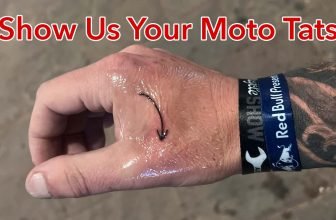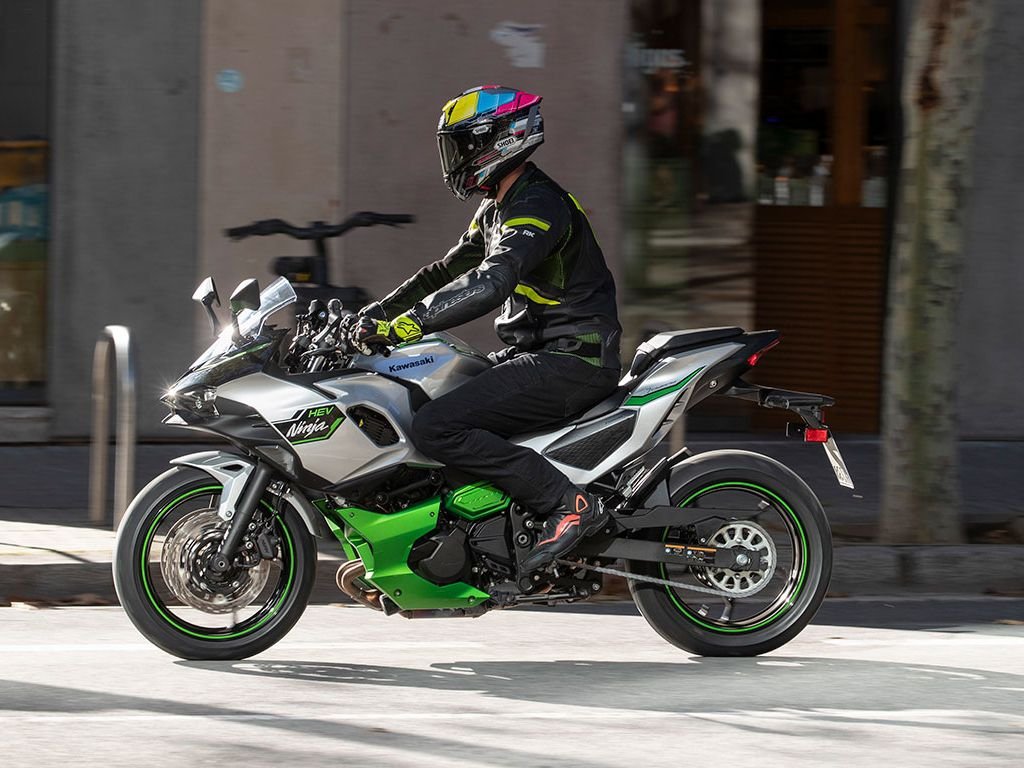
[ad_1]

It’s attention-grabbing to contemplate what the e book on the electrification of bikes will appear like a decade from now. There shall be chapters on the startups that led the preliminary cost and the bikes that modified the general public’s notion of electric motorcycles. There shall be tales in regards to the throng of electrical bicycles that attracted a brand new technology of riders, the businesses that didn’t ship on their guarantees, and on the manufacturing powerhouses that lastly determined to enter the sport.
There may even be a chapter on hybrid bikes, and it’ll undoubtedly begin with a point out of the Kawasaki Ninja 7 Hybrid, the primary mass-production robust hybrid motorbike—Kawasaki’s two-wheeled resolution for the trendy world, the place Zero- and Low-Emissions Zones are very a lot a actuality. Even when they haven’t made their method to the US, but.
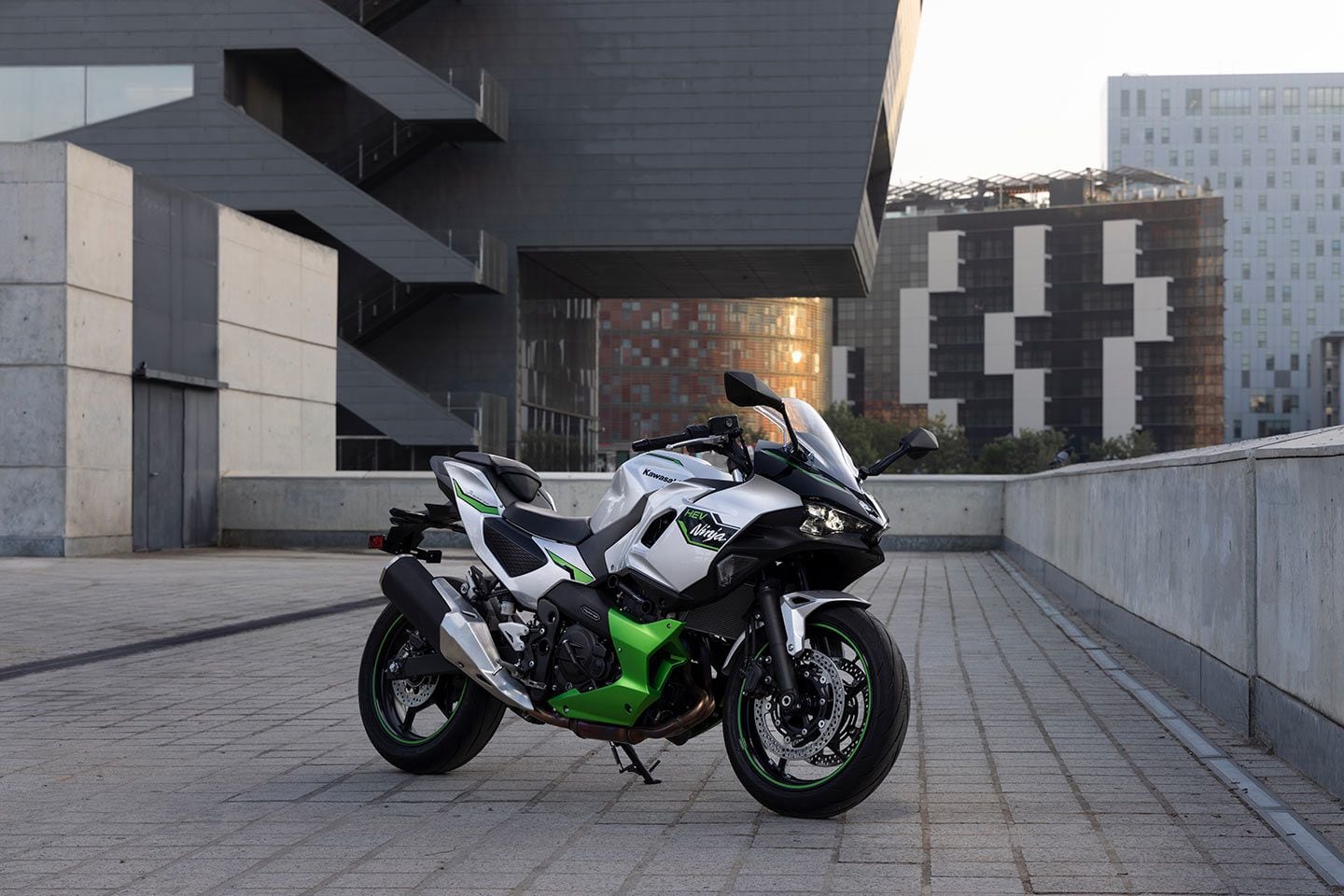
Hybrid Options and Extra
Key phrase within the Ninja 7 Hybrid description is “robust,” which signifies that the Ninja 7 Hybrid’s 451cc inner combustion engine (ICE) and electrical motor can run concurrently or energy the bike impartial of each other, even when the electrical motor is sized for slower speeds (sub-40 mph) and brief distances (round 7 to 10 miles).
Motion is equivalent to what you’ve come to count on from a hybrid automobile, however completely different from that of a light hybrid (MHEV), which makes use of battery energy to scale back the engine’s workload in sure conditions however to not propel the car. This additionally differs from a plug-in hybrid (PHEV), which usually makes use of a bigger battery and must be plugged into {an electrical} outlet or charging station. No want to fret about discovering a working charging station or fussing with cables; the Ninja 7 Hybrid’s battery is charged whereas driving through the engine and regenerative braking.
Associated: 2024 Kawasaki Ninja E-1 and Z e-1 Electric Motorcycles Announced
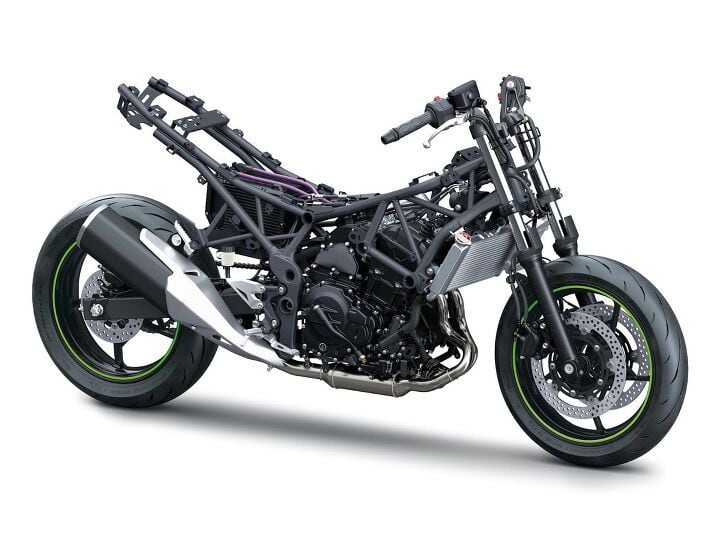
Daring and new because the idea could be, a minimum of within the motorcycling world, Kawasaki has lengthy hinted at its intentions to convey forward-thinking fashions to the market as a part of its “work towards a greener future, with the final word objective of carbon neutrality.” Extra proof of that dedication comes within the type of the corporate’s all-electric Z e-1 and Ninja e-1 city commuters, in addition to the hydrogen-powered concept that it’s teased.
The 7 Hybrid differs from these fashions in its try to be three bikes in a single. Consider it as a zero-emissions bike for closely restricted metropolis facilities, a fuel-sipping city cruiser, and a completely succesful canyon carver capable of tackle 200-plus mile days, suggests Kawasaki.
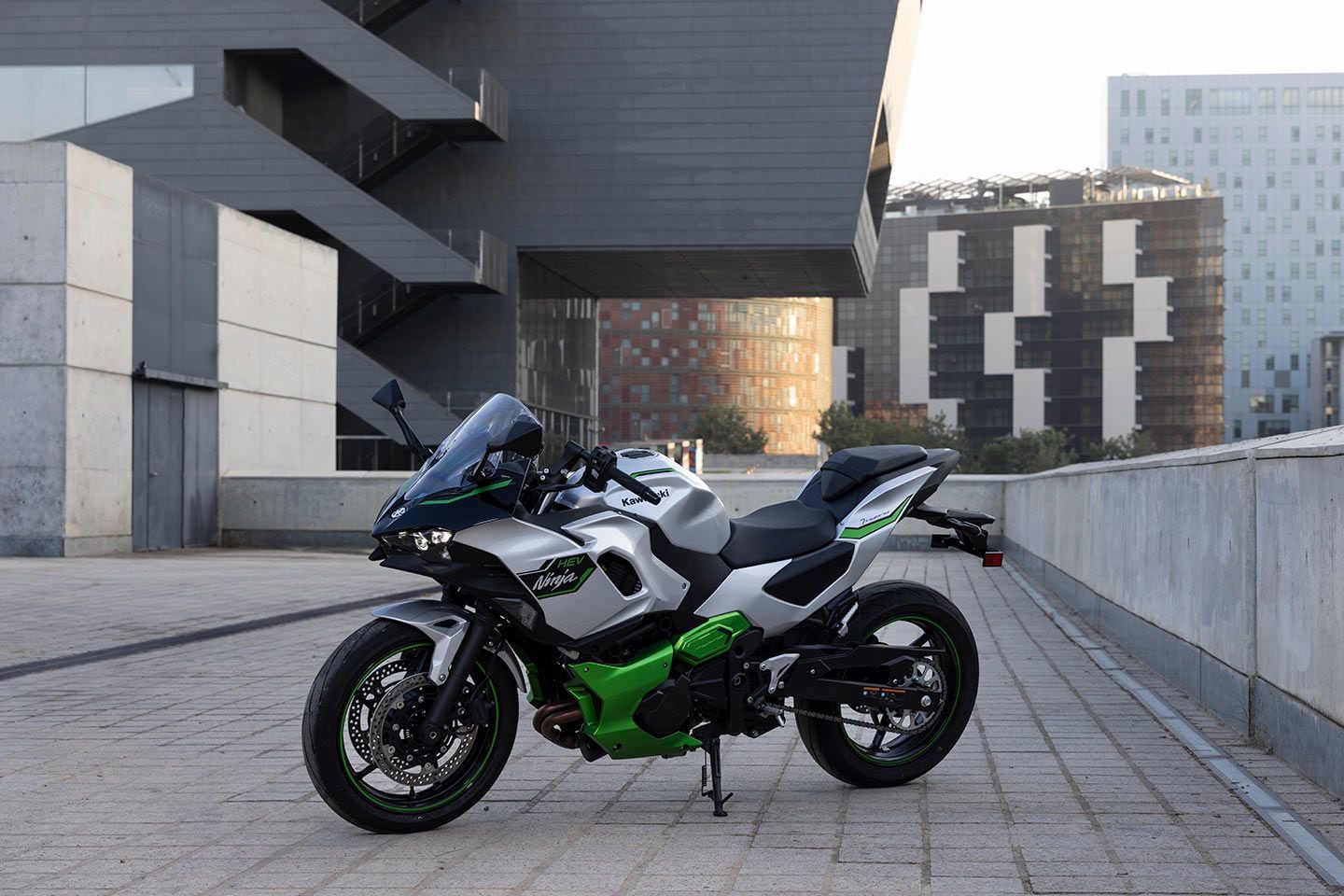
Chassis: Similar however Totally different
Whereas hybrid automobiles have been a “mainstream” various because the early 2000s when Honda launched the Perception and Toyota the primary Prius, Kawasaki engineers admit that designing a hybrid motorbike wasn’t straightforward given the packaging and weight limits innate to motorcycling.
The answer was to pair a light-weight, Ninja 400–impressed metal trellis body with a bolstered swingarm pivot space to an extended swingarm and bottom-mount shock linkage. This configuration permits the Ninja 7′s battery pack to be positioned underneath the seat and for engineers to not dramatically disturb the middle of gravity.
Including a “7″ to the title suggests the bike shall be sized and carry out extra like a middleweight twin than a small-displacement machine. Suppose, Ninja 650 versus Ninja 400.
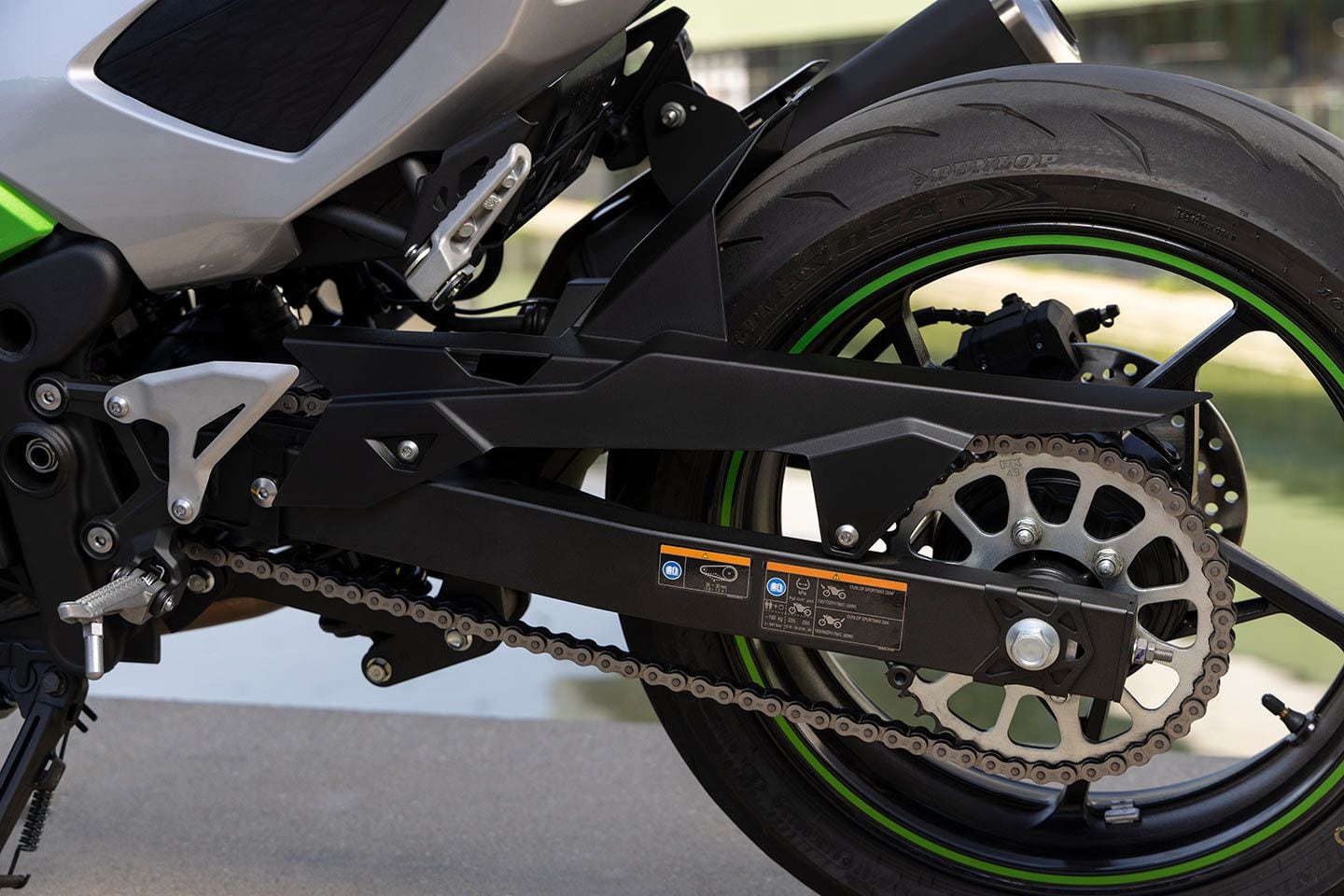
That largely feels just like the case as you throw a leg over the Ninja 7, although key specs paint an image of compromise: The 7 Hybrid’s 60.4-inch wheelbase is 4.9 inches longer than the Ninja 650′s and 6.5 inches longer than the Ninja 400′s, whereas weight (500 kilos) is up 77 kilos when in comparison with the Ninja 650 and 134 pound when in comparison with the Ninja 400. Rake is a extra relaxed 25 levels in comparison with 24 levels on the Ninja 650 and 24.7 levels on the Ninja 400, whereas path is 4.1 inches, versus 3.9 inches and three.6 inches on the 650 and 400, respectively. It is a very completely different motorbike not solely from a efficiency standpoint, however from a geometry standpoint as nicely.
Suspension settings are distinctive to the Ninja 7 Hybrid because of a mixture of stiffer springs and extra aggressive valving, which accounts for the added weight. Twin 300mm entrance brake discs are used for a similar motive. The bike seems to be very very similar to a conventional motorbike with its fairings on, the exception being some distinctive traces on the rear and a swollen-looking tailsection, which helps conceal the bike’s battery.
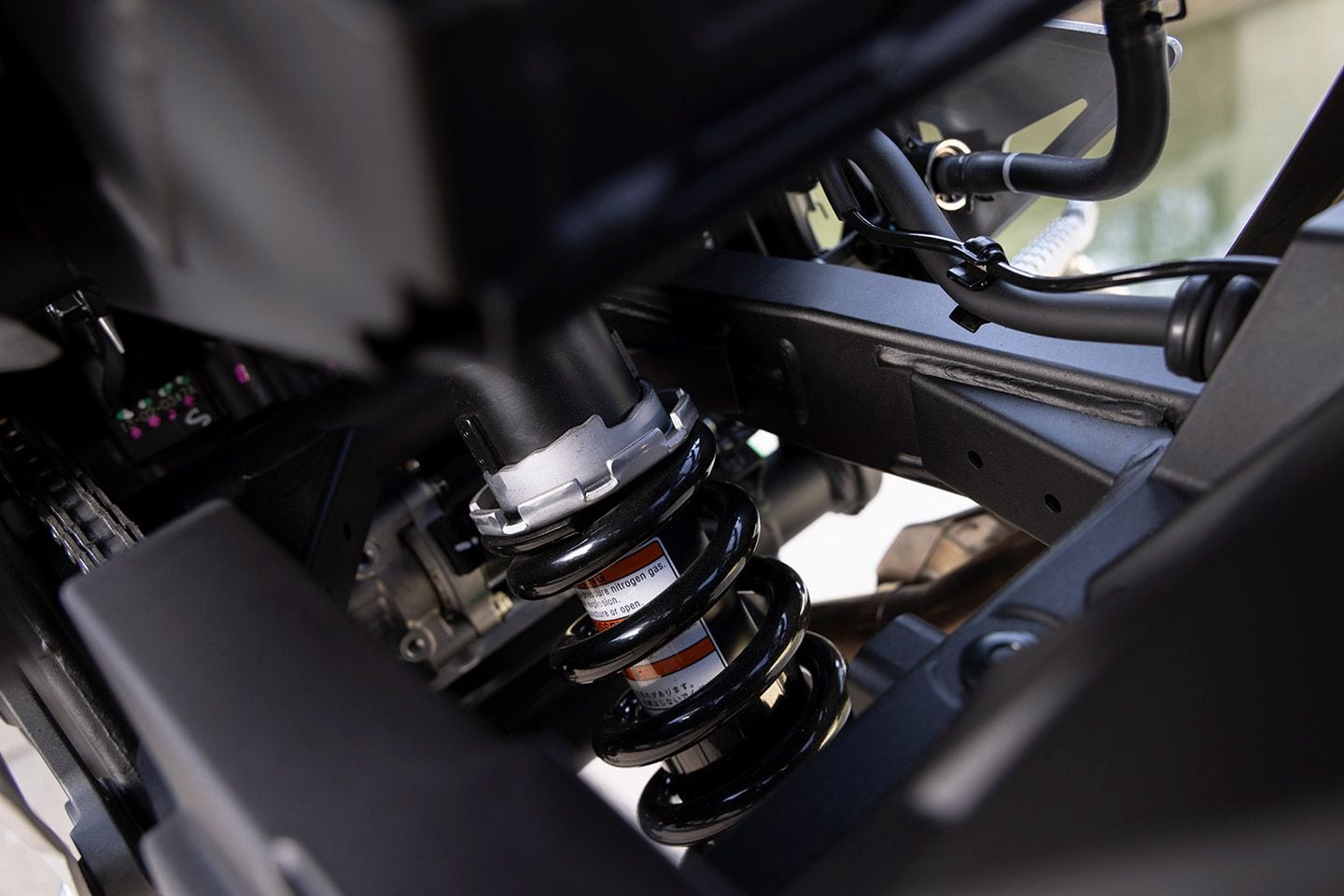
Engine and Traction Motor
It’s what’s underneath these fairings that warrants essentially the most consideration; on this case you’re a 451cc parallel-twin engine borrowed from the Kawasaki Eliminator however up to date with new velocity stacks, a reconfigured exhaust header, and extra aggressive mapping. Stated modifications are for elevated top-end efficiency, in keeping with Kawasaki engineers, as low-end efficiency is already bolstered by the 7′s electrical motor.
Kawasaki claims that, in Ninja 7 Hybrid trim, the 451cc engine makes 58 hp at 10,500 rpm and 32 lb.-ft. of torque at 7,500 rpm.
The motor is a liquid-cooled, 7kW (9kW max) inside everlasting magnet sort, mounted behind the engine’s cylinders. Energy comes from a 48V lithium-ion battery, cooled through an air duct that runs alongside the best aspect of the bike. The motor and battery weigh roughly 29 kilos every, however issue within the further {hardware}—together with a separate radiator for the electrical motor—and also you begin to see the place the Ninja 7 Hybrid’s added weight comes from.
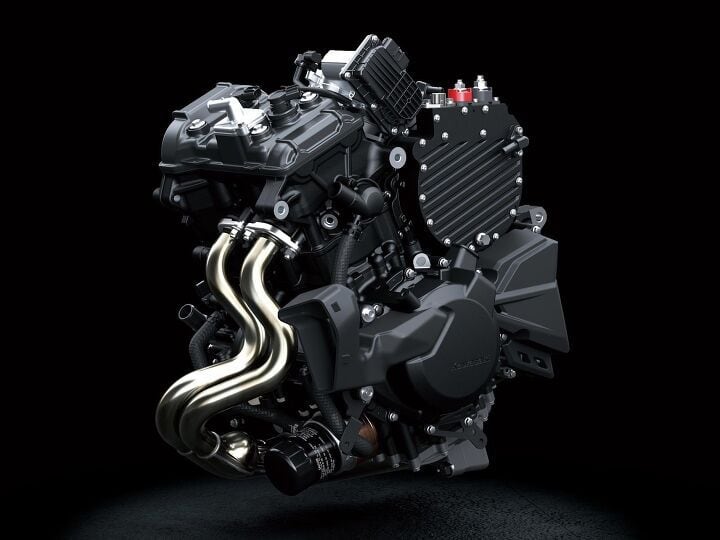
Importantly, Kawasaki says that the motor and battery had been developed with the assistance of suppliers (Wamtechnik for the battery, Delta Electronics for the traction motor), however that every one digital administration was performed by Kawasaki.
There are a number of different tips up the Ninja 7′s sleeve, together with Kawasaki’s first Built-in Starter Generator (ISG), which saves weight by combining the capabilities of the starter motor and generator. Extra thrilling is the six-speed, automated guide transmission that permits riders to pick out between an computerized or guide button-shift setting. There isn’t a clutch lever or shift lever; in guide, the rider shifts utilizing buttons on the left handlebar change cluster.
That’s a straightforward sufficient factor to grasp, however a way more tough one to make work when managing energy from an electrical motor and engine. Kawasaki engineers admit that, exterior of packaging, software program administration was certainly one of their greatest challenges.
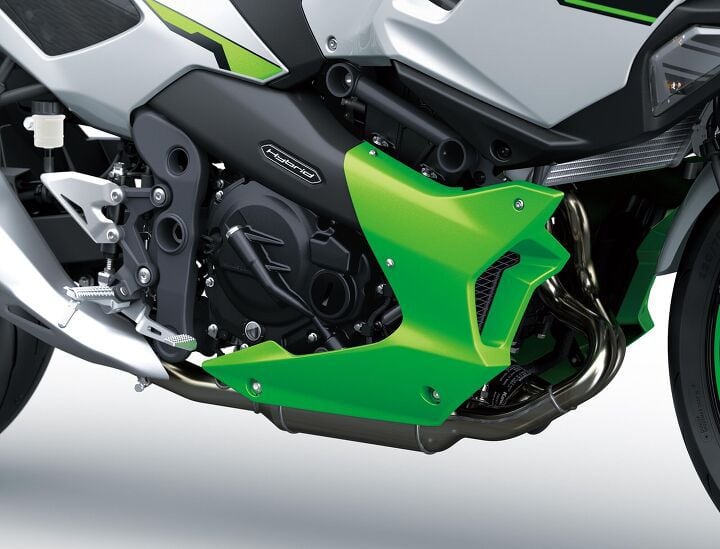
Driving Modes
Complexities don’t finish there as Kawasaki has added trip modes to the Ninja 7 Hybrid, together with all-electric EV, Eco-hybrid, and Sport-hybrid. Right here’s a have a look at the options and efficiency out there in every of these modes:
- EV: Designed for low-speed, short-distance driving, like in residential or restricted areas. The bike is powered solely by the electrical motor, and shifts are performed by the bike, with shift timing decided by the ECU. Solely gears one via 4 are used.
- Eco-hybrid: Supposed to be one of the best of each worlds. The electrical motor is used when shifting from a begin, with the engine beginning and coming on-line at round 2,000 rpm. When stopped, the engine turns off to preserve gasoline. Riders can choose between computerized or guide transmission settings, although the ability is neutered barely on this mode as the first objective is gasoline economic system.
- Sport-hybrid: Designed for extra spirited driving, profiting from the 2 energy methods. The 451cc engine makes max energy and is at all times on as there’s much less emphasis on gasoline consumption. Riders are restricted to the guide transmission possibility solely.
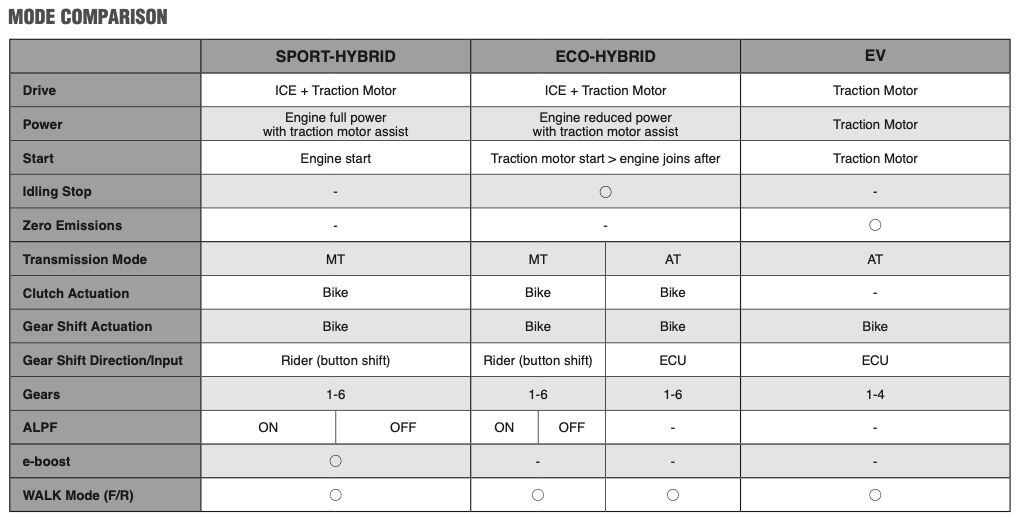
However, wait, there’s extra. Or a minimum of there’s extra for very transient quantities of time, as Kawasaki has added an e-boost operate, which makes use of battery energy to extend efficiency for as much as 5 seconds. The function is just out there in Sport-hybrid mode and when sure situations are met (touring above a sure pace, throttle is opened previous a sure diploma, and so on.), however will increase claimed energy output to 68.5 hp and 44.6 lb.-ft. of torque.
The very best half? Kawasaki says that, with e-boost activated, the Ninja 7 Hybrid can “initially” out-accelerate a ZX-10R from a standing begin.
For slower maneuvers, there’s a strolling mode with ahead and reverse operate. All of that is adjusted and confirmed through the 4.3-inch TFT show which is busy however nicely organized. Riders can even verify settings, and test battery standing or different necessary info via Kawasaki’s Rideology app.
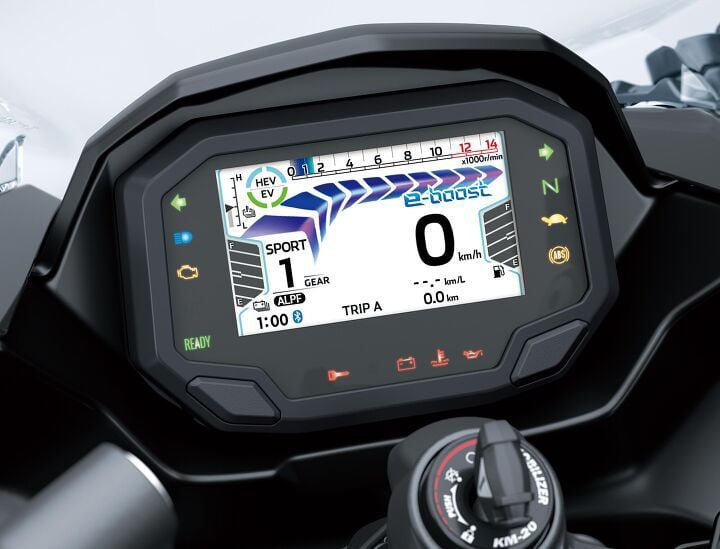
Trip Mode, Engaged
There wasn’t a ZX-10R available throughout our Ninja 7 Hybrid trip expertise to check Kawasaki’s acceleration claims, however flying to Barcelona, Spain, to throw a leg over the bike did give us an opportunity to strive the bike in an space the place low-emission zones (LEZs) are already a actuality—Barcelona’s ring highway LEZ features a 37 square-mile space the place autos deemed heavy polluters are prohibited. And whereas that doesn’t restrict bikes, scooters, or most late-model household automobiles, it factors to a future the place EV and HEV fashions are rewarded with entry to metropolis facilities or different closely restricted areas. And there we had been, on the primary mass-production HEV motorbike. Becoming.
There are extra surprises as you throw a leg over the Ninja 7 Hybrid, primarily the array of buttons and the distinctive course of for getting the bike fired up and into gear. This isn’t a very advanced course of, however steps should be taken within the right order, and it takes a minute to commit that course of to reminiscence. As an illustration, when you plan to depart in EV mode, it’s essential to first begin the bike utilizing the engine, choose EV, then click on into first gear.
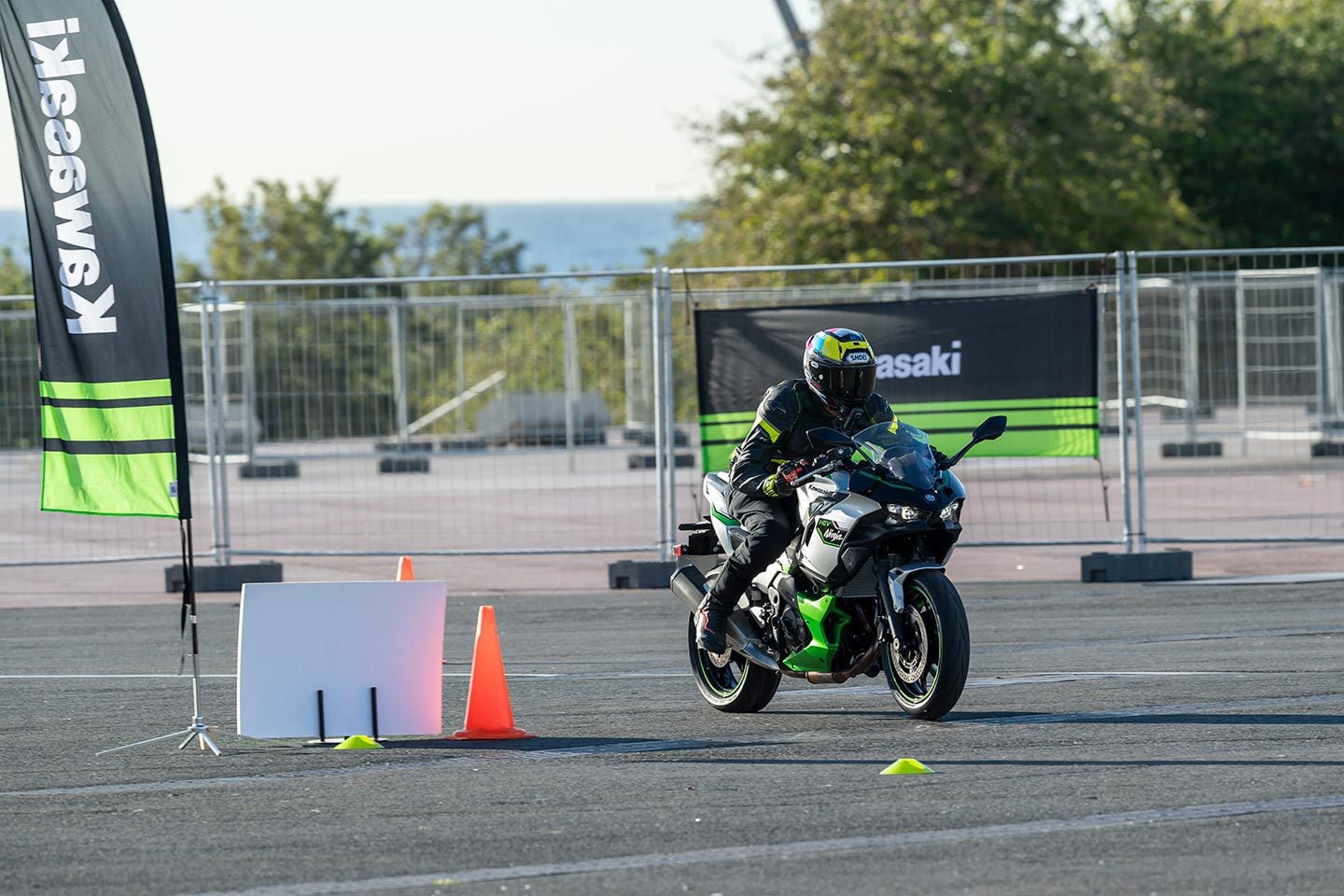
Kawasaki acknowledged there can be a familiarization interval and took us to the close by Parc del Fòrum, the place we may follow switching between EV and HEV modes, take a look at acceleration, and pattern each transmission choices. The takeaway? It should take time to get totally comfy with the added intricacies of the hybrid platform, and whereas which may deter novice riders who’ve sufficient to fret about as they set about on their driving journey, it’s not unattainable for this to develop into second nature.
Shifting out and in of Parc del Fòrum was additionally an instance of how helpful it’s to have the ability to change over to EV mode when the second is correct; there’s one thing about easing previous folks on a quiet motorbike that modifications their notion of “motorcycling.” Again at residence within the US, this may appear like being the one who doesn’t wake the neighborhood up after they go away early or come residence late.
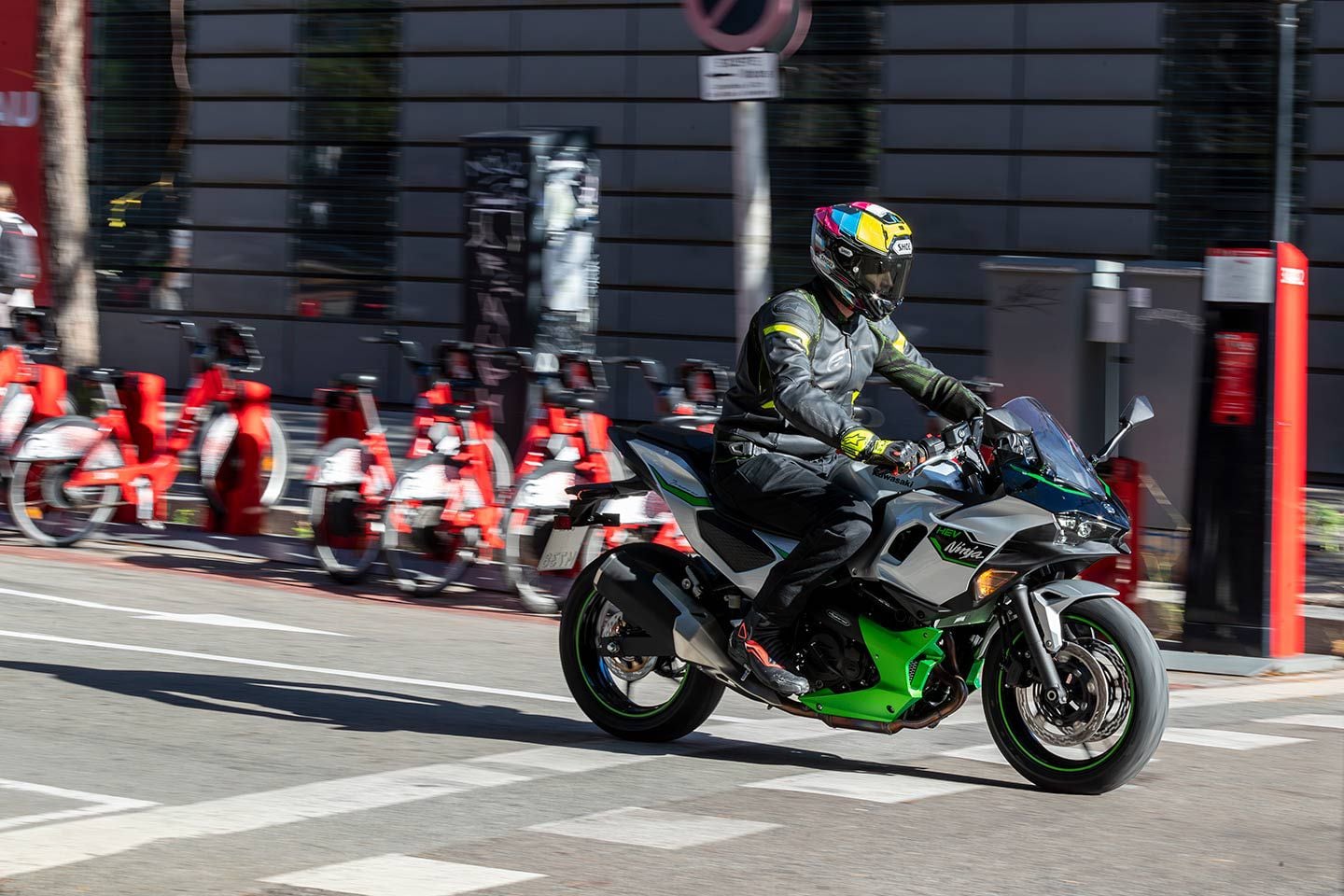
Vary is proscribed to a claimed 7.5 miles in EV mode, although that quantity varies relying on the driving fashion. We rode roughly 5 miles via Barcelona’s metropolis heart with out seeing the EV vary drop by greater than 2 miles because of the regenerative braking system. In regular driving situations, the battery will go from zero to totally charged in 50 minutes, so you may count on to trip round in Sport-hybrid mode for a while when you fully drain the battery.
High pace in EV is just below 40 mph, and whereas the bike doesn’t bounce off the road with the identical sense of urgency as a high-voltage, all-electric bike, it’s fast sufficient to maintain up with low- to medium-speed site visitors in around-town driving.
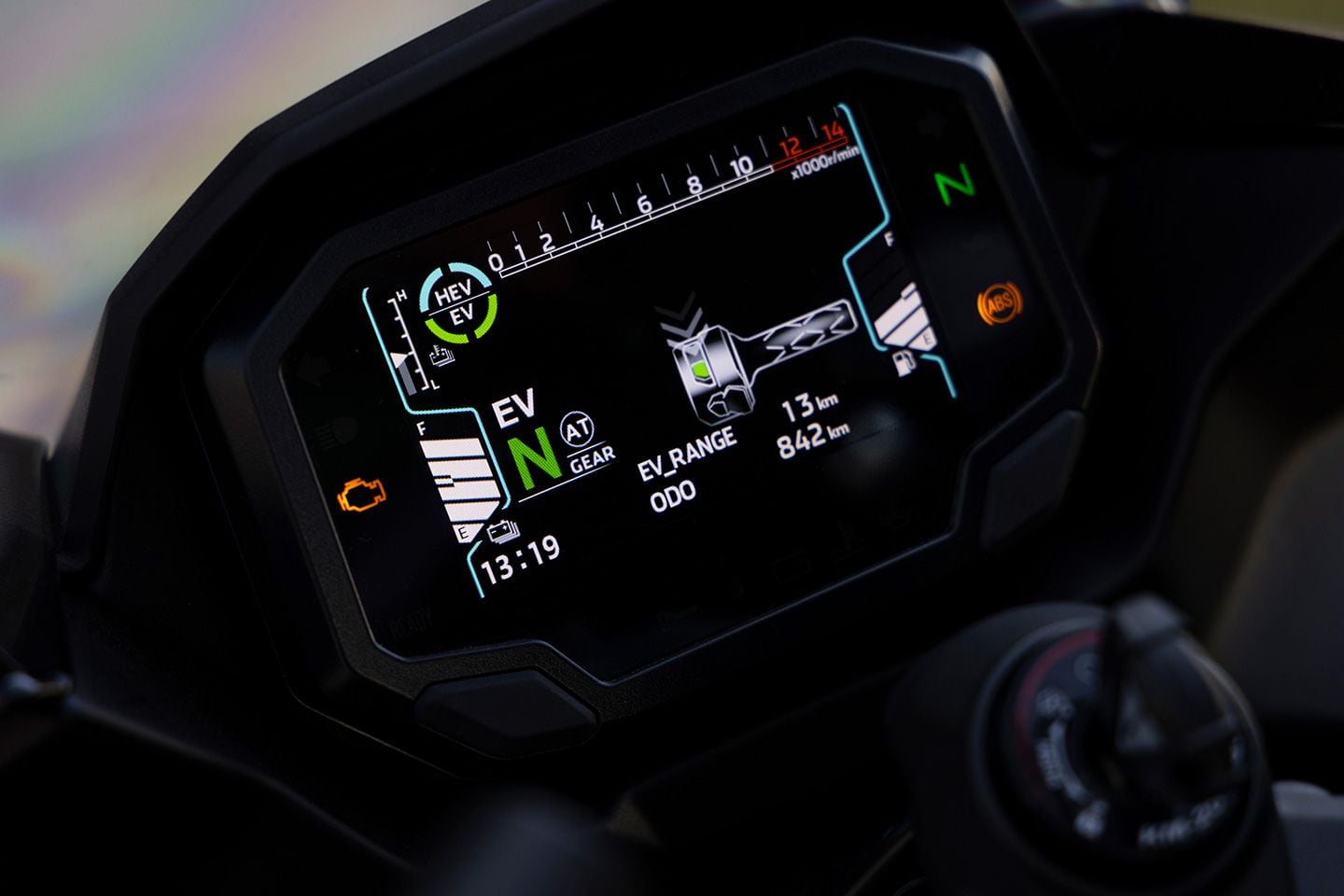
Switching from EV to the Eco-hybrid provides a glimpse into the added versatility of the Ninja 7 Hybrid, as you’re now not centered on battery vary—an ever-present concern for EV homeowners. Emphasis remains to be on gasoline consumption, demonstrated by the tender engine mapping and overzealous shift logic for the automated transmission, which ensures you go to excessive gear virtually instantly. It’s like enjoying eco-Monopoly: “Go on to [high gear]; don’t [speed], don’t [burn gas].”
Switching to the guide transmission setting allows you to management shifting. Though, admittedly, we’d want when you might be in AT mode and briefly override the pc. In present trim, hitting the shift paddles routinely strikes you to the guide transmission setting. That continues to be the case till you choose AT once more. Once more, there’s quite a lot of button pushing right here.
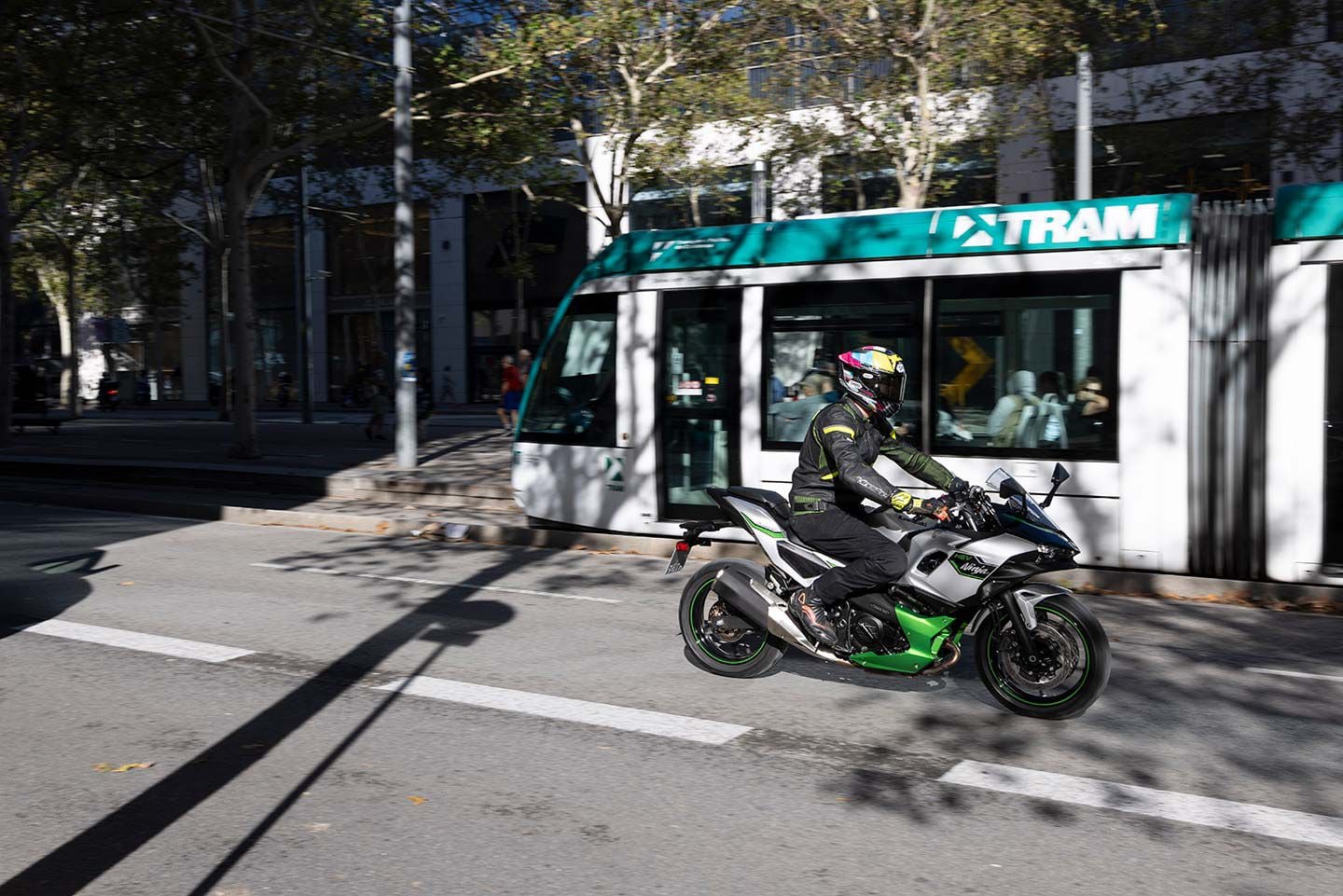
The handoff between electrical motor and the parallel-twin engine is surprisingly seamless and noticeable extra from an audible standpoint than the rest. Provided that the transition occurs at round 2,000 rpm, you’re virtually assured to be upright and cruising at low speeds when it occurs, so no want to fret about upsetting the chassis because the bike switches to the inner combustion engine.
Even when the bike had been to transition whereas at lean, Kawasaki’s engineers did a ok job with the software program that this wouldn’t be a difficulty. Of all of the issues that stand out most on the Ninja 7 Hybrid, it’s how seamless the electronics work, from computerized shifts to the EV/HEV handoff. The identical goes for throttle utility and regenerative braking system; every thing feels as it will on a conventional motorbike. Nothing interferes along with your expertise.
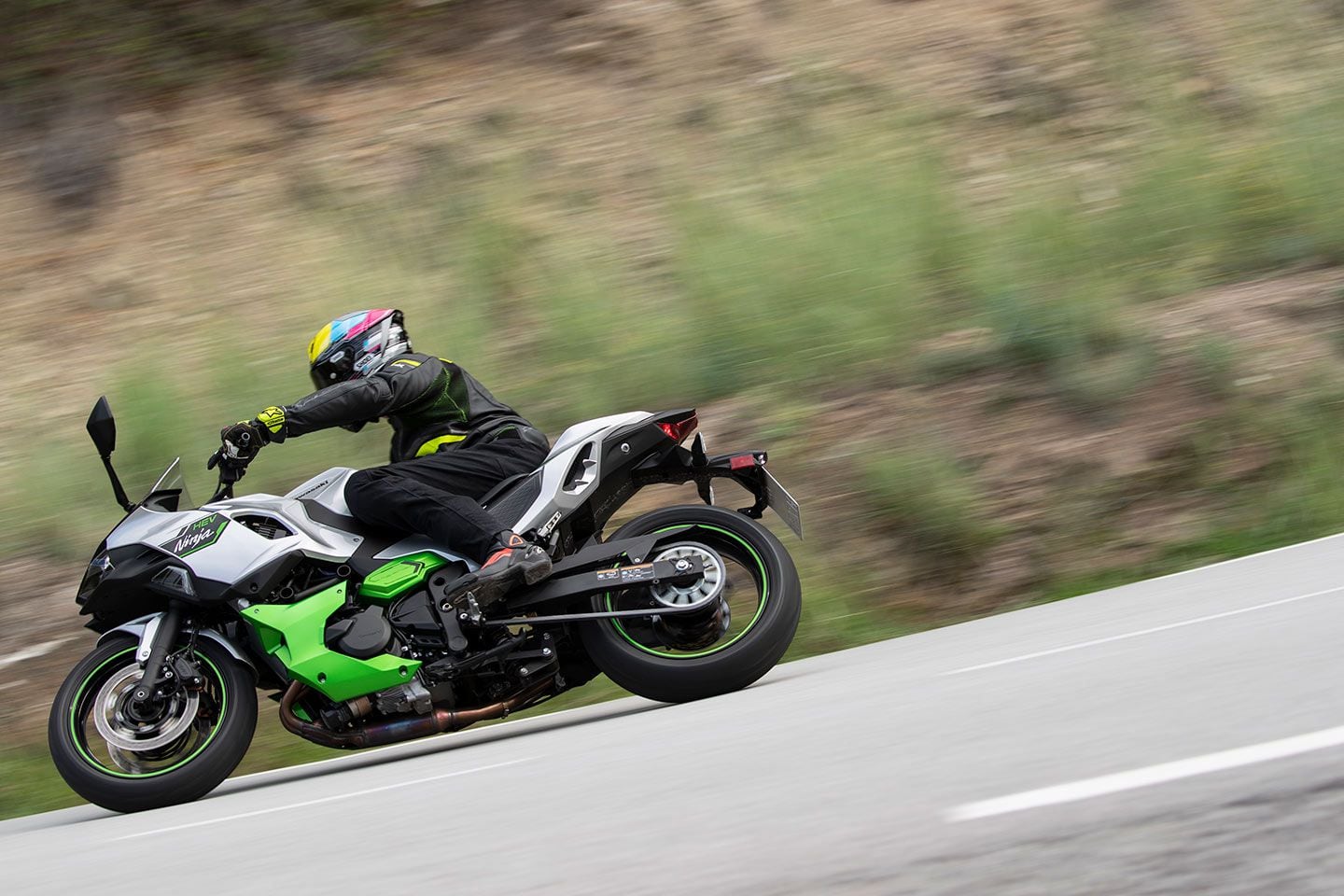
If all of this makes it sound like driving the Ninja 7 Hybrid is paying homage to driving a conventional motorbike, that’s as a result of, nicely, it’s. That’s very true while you toggle over to Sport-hybrid and put Kawasaki’s 451cc engine to work. Probably the most fuel-efficient strategy? Perhaps not, however it’s laborious to argue with the sporty persona of this newest parallel twin, which willingly pulled us via a number of the greatest two-lane roads lining Barcelona with out feeling prefer it wanted to return up for air, and solely a touch of vibration to remind you that this can be a small-bore machine at its core.
That efficiency is, after all, with out utilizing the e-boost function, which propels the Ninja 7 Hybrid as much as speeds the Ninja 400 may solely dream of for as much as 5 seconds. The one downside is that activating e-boost requires you to concentrate on its standing and have your proper thumb on the e-boost button; this takes further consideration and isn’t one thing we wished to be centered on whereas looking apexes within the canyons or managing site visitors, which means we used it lower than one may count on. There’s in all probability a motive you don’t see one thing comparable in immediately’s newest hybrid cars.
That mentioned, e-boost is sensible while you’re on the freeway and wish further pace to speed up previous a automobile. The five-second bursts are simply lengthy sufficient to really feel some pleasure, with out overheating the battery. Maybe one of the best instance of the e-boost efficiency stage is its capacity to throw you again within the seat when used from a standing begin.
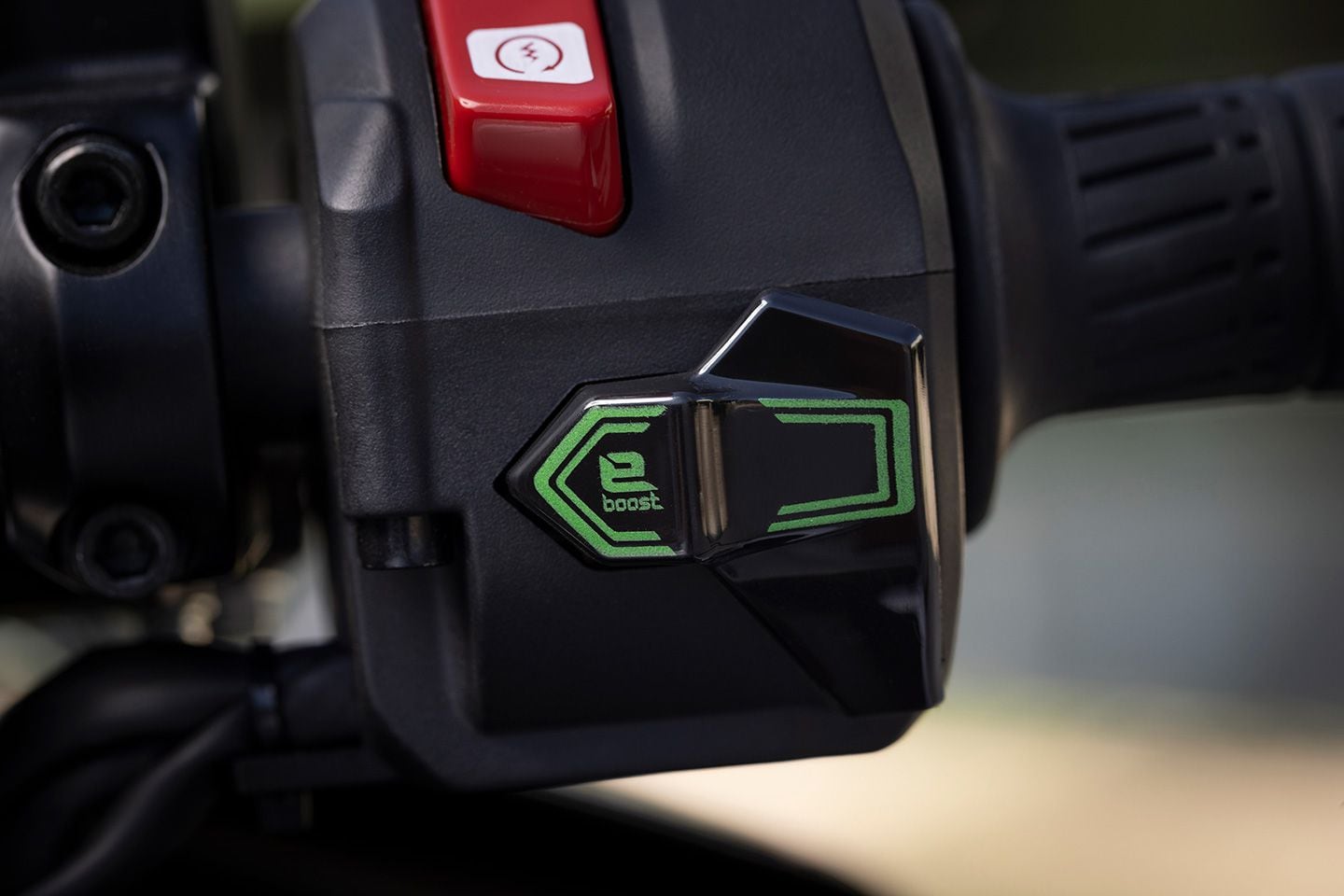
As for vary, we rode in a wide range of situations over our two days on the bike, and averaged roughly 57 mpg, in keeping with the bike’s onboard pc. That features numerous dragstrip-style launches and a spirited afternoon within the canyons, but in addition a full morning of placing via town. Typical driving for a motorcycle like this? Not precisely, so we’ll save additional gasoline economic system feedback for future testing.
What we will say is that, based mostly on World Bike Check Cycle (WMTC) testing, which measures gasoline consumption and emissions in bikes, the bike is rated at 58 mpg in Sport-hybrid mode, and 64 mpg in Eco-hybrid mode.
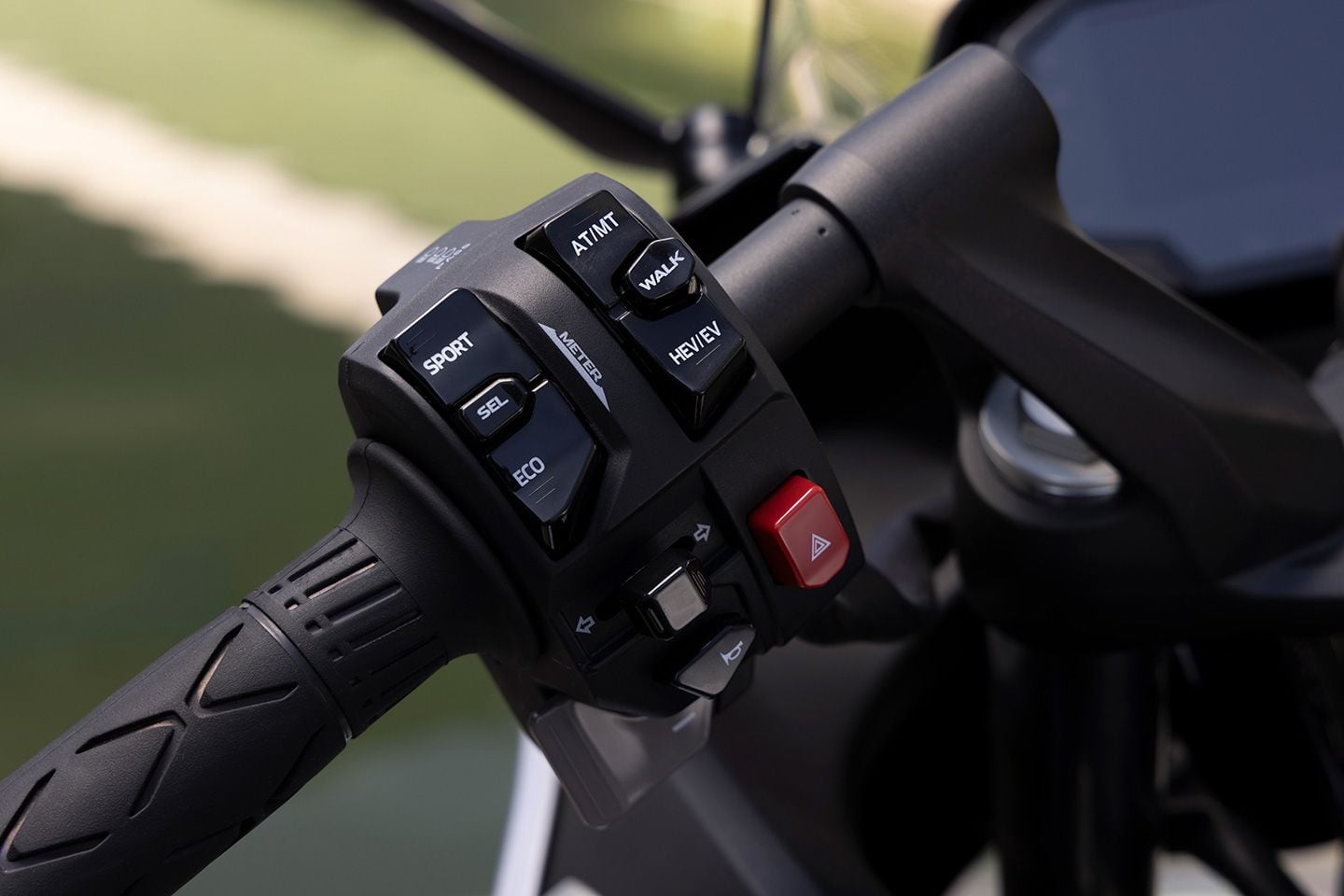
Dealing with
Whereas packaging and software program had been a serious focus for Kawasaki, dealing with was additionally a precedence—the entire “three bikes in a single” doesn’t maintain a lot weight if the Ninja 7 doesn’t encourage riders to get out of town and really trip. Fortuitously, the staff has performed a great job managing the added heft and bigger dimensions, creating a motorcycle that doesn’t wave the white flag on a winding part of asphalt.
That’s to not say the Ninja 7 handles like a Ninja 400 or Ninja 650. These bikes tip right into a nook and maintain their line with absolute ease, whereas it’s essential to be a little bit extra intentional with steering inputs right here. An extended wheelbase means the bike suggestions in slower, then falls into the nook . You additionally want to make use of a little bit further enter midcorner to maintain the bike in your supposed line.
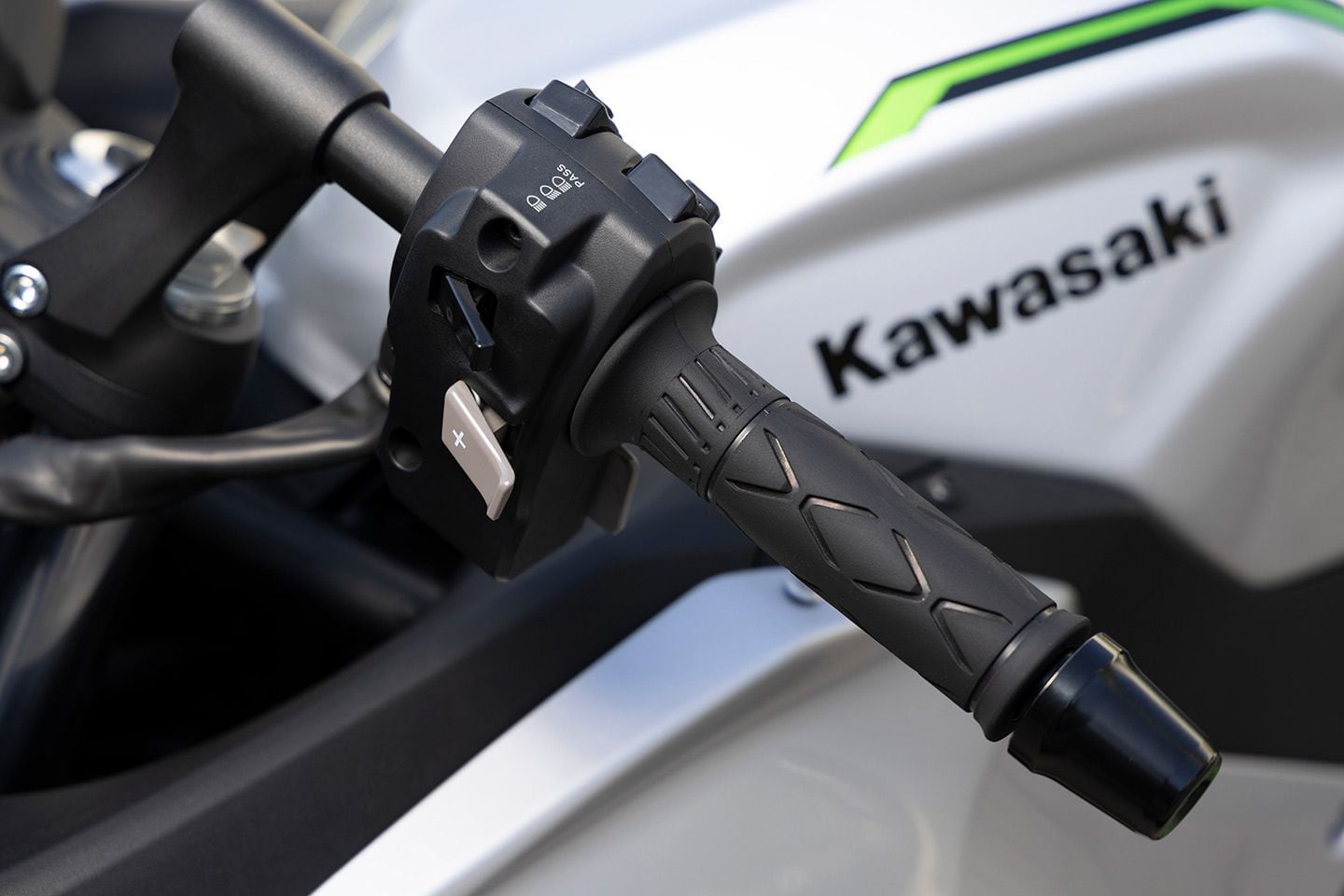
It’s not a tiring exercise although, and once more, you’d be shocked at how nicely the Ninja 7 hustles via a decent part of highway. Sustaining a low heart of gravity helps, as do the large handlebars. You sit upright and relaxed, however with sufficient weight over the entrance of the bike to assault a nook do you have to please. One other huge assist right here is the stiffer suspension and bolstered body, which do an admirable job of maintaining the Ninja 7 from wallowing round because the tempo picks up. That is nonetheless an gratifying motorbike to trip rapidly.
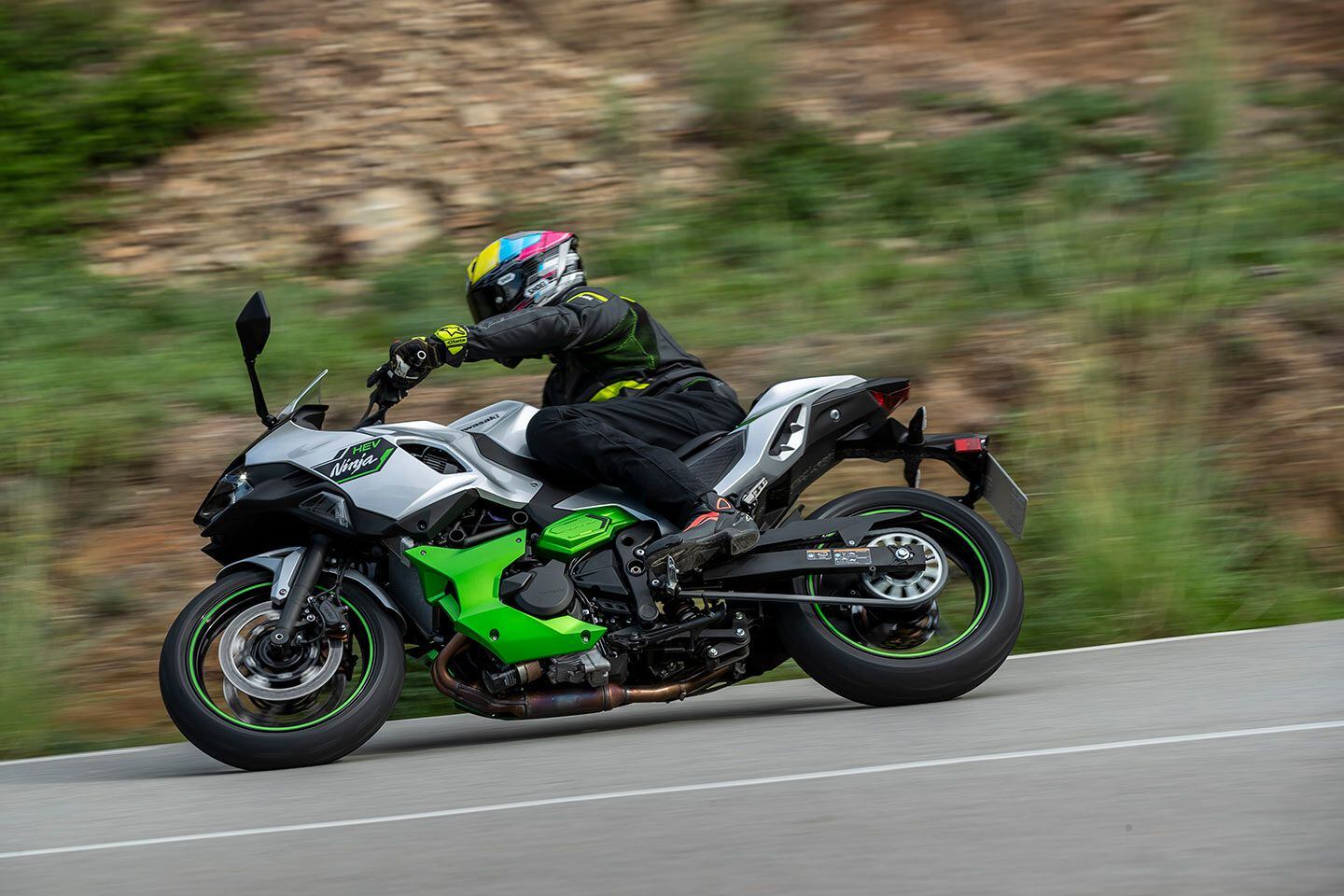
Ultimate Ideas
Whereas the Ninja 7 Hybrid is Kawasaki’s first HEV, it received’t be its final. Kawasaki has already mentioned that it’s engaged on the following technology of hybrid bikes throughout completely different platforms. In that regard, the Ninja 7 Hybrid is one thing like a style of what’s to return.
Is it a great first style? We predict so. Individuals may count on a first-gen hybrid motorbike to have teething points and need to keep away, however there are none right here. Fueling is clean, there’s no hesitation because the bike transitions from electrical motor to gasoline engine, the automated guide transmission works nicely, and regardless of being a little bit heavy, the bike remains to be loads of enjoyable to trip when the roads tighten up.
Our solely concern is with the added complexity that comes with the numerous trip modes, buttons, and options you may need to modify whereas driving. House owners will in all probability adapt to that, however it’s one thing to contemplate. Maybe future fashions will really feel a little bit extra “turn-key.”
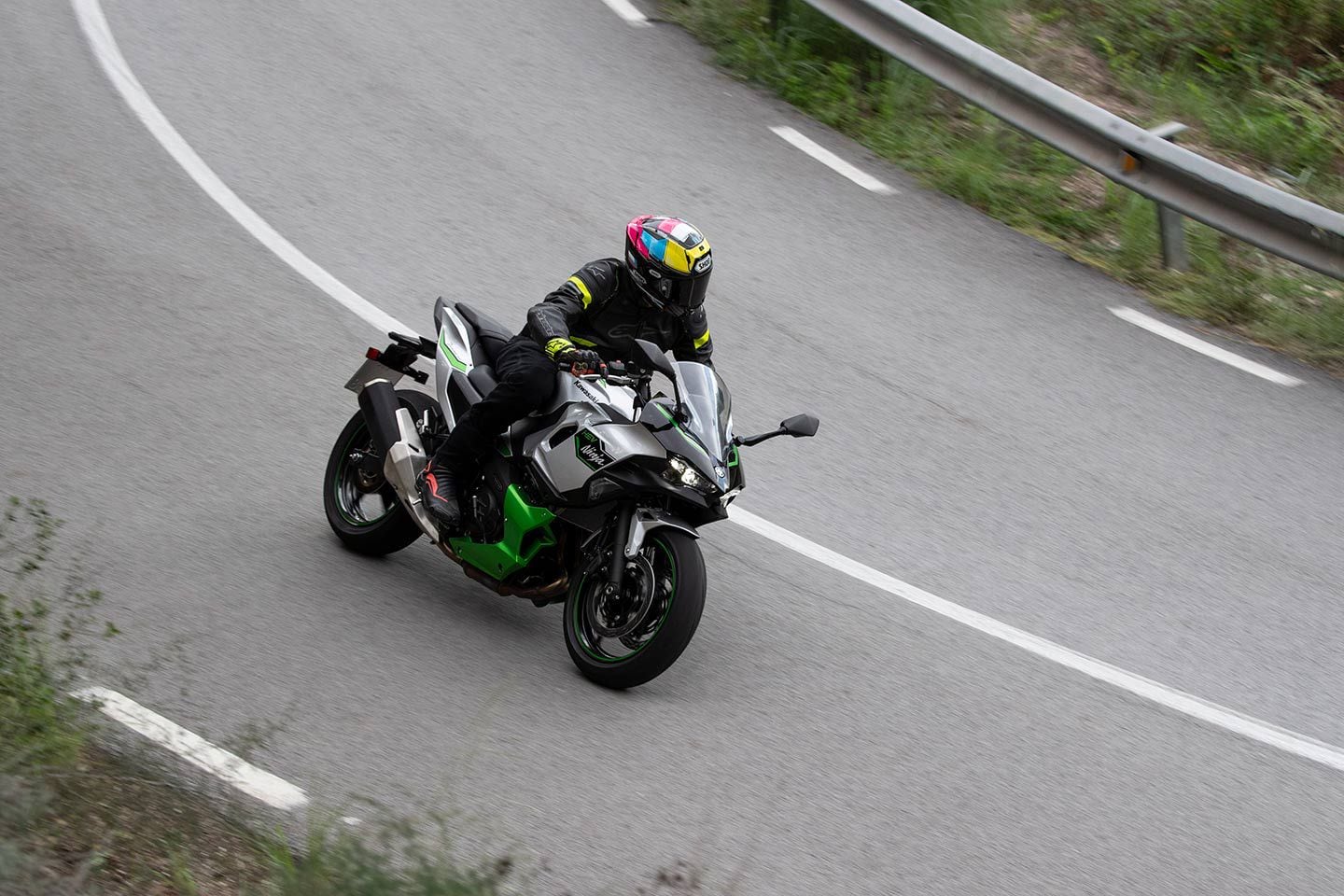
None of this takes into consideration worth, as Kawasaki has but to formally announce the Ninja 7 Hybrid for the US market, or recommend a worth goal. The fact is there are various inexpensive and economical bikes already available on the market (e.g., Honda NC750X), thus gross sales success will depend upon individuals who really feel the advantages outweigh regardless of the added price could be. Which may be a small group, smaller even given there aren’t any Zero- or Low-Emissions Zones within the US but, and on condition that motorcyclists within the States are motivated extra by ardour than gasoline economic system.
Early adopters and those that merely respect the tech will, nevertheless, be rewarded by a motorcycle that not solely writes a brand new chapter in motorcycling, however does so in a approach that isn’t too far faraway from driving as we all know it.
2024 Kawasaki Ninja 7 Hybrid Specs
| MSRP: | N/A |
|---|---|
| Engine: | DOHC, liquid-cooled, 4-stroke parallel twin |
| Displacement: | 451cc |
| Bore x Stroke: | 70.0 x 58.6mm |
| Compression Ratio: | 11.3:1 |
| Motor Kind: | Liquid-cooled, inside everlasting magnet synchronous |
| Battery Kind: | 48V Li-ion |
| Transmission/Ultimate Drive: | 6-speed/chain, return, electronically actuated, hydraulic automated guide transmission |
| Claimed Horsepower: | 68.5 hp @ 10,500 rpm (Sport-hybrid w/ e-boost) |
| Claimed Torque: | 44.6 lb.-ft. @ 2,500 rpm (Sport-hybrid w/ e-boost) |
| Gasoline System: | DFI w/ 36mm throttle our bodies |
| Clutch: | Moist, multiplate, automated |
| Engine Administration/Ignition: | Digital |
| Body: | Trellis, high-tensile metal |
| Entrance Suspension: | 41mm telescopic fork; 4.7 in. journey |
| Rear Suspension: | Single shock, spring preload adjustable; 4.5 in. journey |
| Entrance Brake: | 2-piston calipers, 300mm discs (w/ ABS) |
| Rear Brake: | 2-piston caliper, 220mm disc (w/ ABS) |
| Wheels, Entrance/Rear: | 5-spoke; 17 in./17 in. |
| Tires, Entrance/Rear: | 120/70-17 / 160/60-17 |
| Rake/Path: | 25.0°/4.1 in. |
| Wheelbase: | 60.4 in. |
| Floor Clearance: | 5.9 in. |
| Seat Peak: | 31.3 in. |
| Gasoline Capability: | 3.7 gal. |
| Claimed Weight: | 500 lb. |
| Contact: | kawasaki.com |
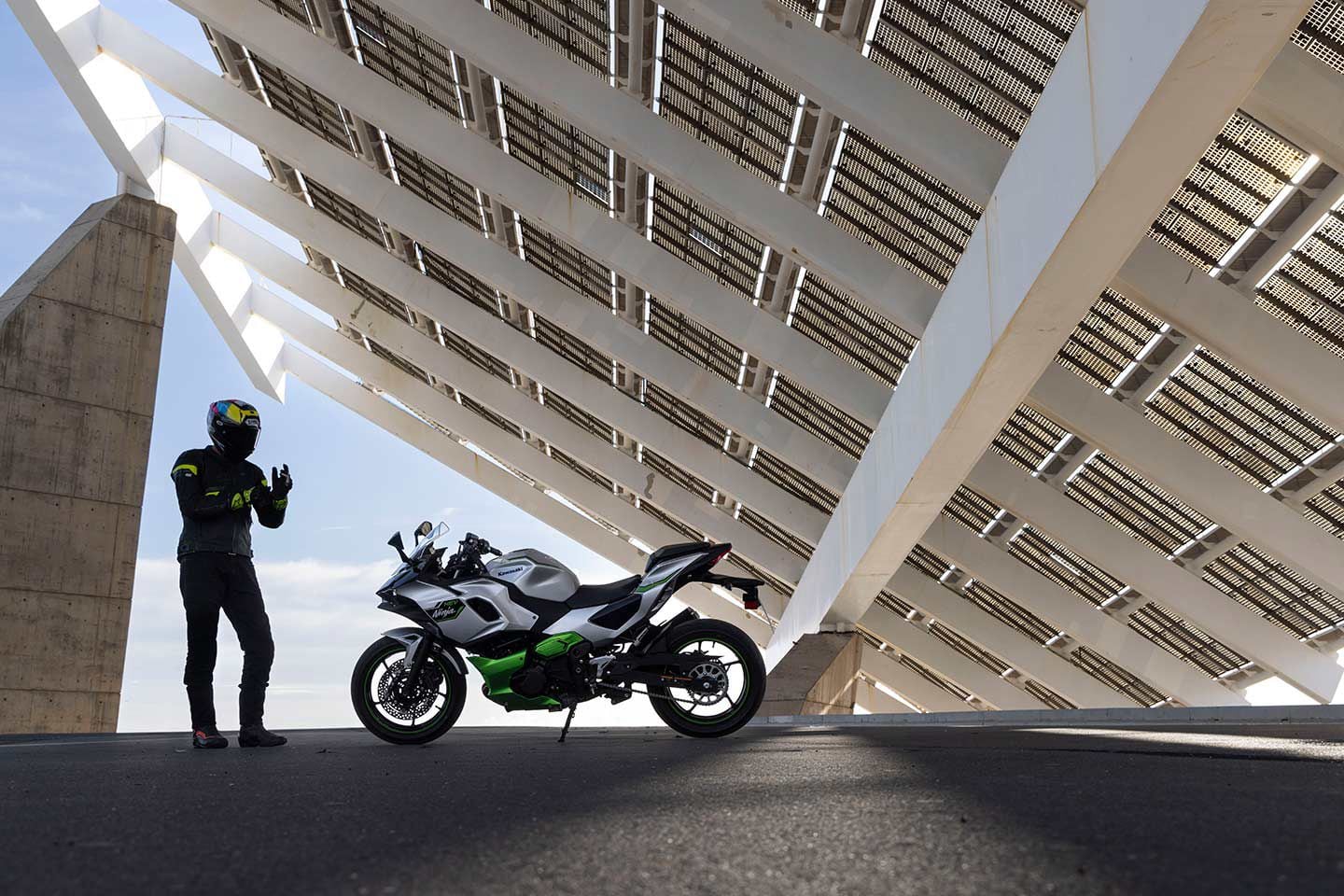
Gearbox
Helmet: Shoei X-Fifteen
Jacket: Alpinestars GP Plus R v3 Rideknit
Gloves: Alpinestars GP Tech V2
Boots: Alpinestars SMX-6 V2 Drystar
[ad_2]
this Article is Supply FromSource link



